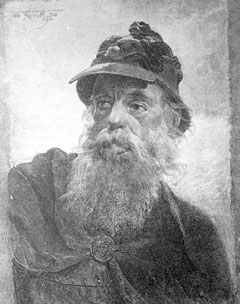
Back Bataille de Fort Loyal French ロイヤル砦の戦い Japanese Slaget ved Fort Loyal NN Slaget ved Fort Loyal NB
| Battle of Falmouth (1690) | |||||||
|---|---|---|---|---|---|---|---|
| Part of King William's War | |||||||
 Baron de St Castin | |||||||
| |||||||
| Belligerents | |||||||
|
New France Wabanaki Confederacy |
| ||||||
| Commanders and leaders | |||||||
|
Joseph-François Hertel de la Fresnière Baron de St Castin Chief Hopehood (Kennebecks) Rene Robinau de Portneuf[1] Augustin Le Gardeur de Courtemanche[2] | Captain Sylvanus Davis[3][4] | ||||||
| Strength | |||||||
| 400-500 troops and natives | unknown | ||||||
| Casualties and losses | |||||||
| unknown | 200 killed | ||||||
The Battle of Falmouth (also known as the Battle of Fort Loyal) (May 16–20, 1690) involved Joseph-François Hertel de la Fresnière and Baron de St Castin leading troops as well as the Wabanaki Confederacy (Mi'kmaq and Maliseet from Fort Meductic) in New Brunswick to capture and destroy Fort Loyal and the English settlement on the Falmouth neck (site of present-day Portland, Maine), then part of the Massachusetts Bay Colony. The commander of the fort was Captain Sylvanus Davis.[5] After two days of siege, the settlement's fort, called Fort Loyal (sometimes spelled "Loyall"), surrendered. The community's buildings were burned, including the wooden stockade fort, and its people were either killed or taken prisoner. The fall of Fort Loyal (Casco) led to the near depopulation of Europeans in Maine. Native forces were then able to attack the New Hampshire frontier without reprisal.[6]
- ^ Taillemite, Étienne (1979) [1969]. "Robinau de Portneuf, Rene". In Hayne, David (ed.). Dictionary of Canadian Biography. Vol. II (1701–1740) (online ed.). University of Toronto Press.
- ^ Corley, Nora T. (1979) [1969]. "Le Gardeur de Courtemanche, Augustin". In Hayne, David (ed.). Dictionary of Canadian Biography. Vol. II (1701–1740) (online ed.). University of Toronto Press.
- ^ Smith, Thomas; Deane, Samuel (1849). Journals of the Rev. Thomas Smith, and the Rev. Samuel Deane, Pastors of the First Church in Portland. J.S. Bailey. p. 434.
- ^ Stewart, Alice R. (1979) [1969]. "Davis, Silvanus". In Hayne, David (ed.). Dictionary of Canadian Biography. Vol. II (1701–1740) (online ed.). University of Toronto Press.
- ^ Captain Sylvanus Davis was of Sheepscot in 1659 and was wounded at Arrowsick at the time Captain Lake was killed. He removed to Falmouth in 1680 and had command of the fort there in the next Indian war. He was captured and carried to Canada, May 20, 1690, and after his return in 1691 entered the Council by the Charter of William and Mary. He wrote an account of the conduct of the war which is in III Mass. Hist. Soc. Coll., Vol. I, page 101. He lived in Hull during the latter part of his life and died in 1704. — Savage.
- ^ Conquering the American wilderness: the triumph of European warfare in ... By Guy Chet; p. 82
© MMXXIII Rich X Search. We shall prevail. All rights reserved. Rich X Search